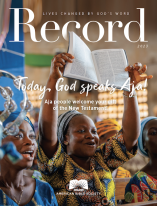How to Have a Balanced Diet of Scripture
The benefits of a more comprehensive reading
I don’t remember much about the decorations in my elementary school classrooms, but one colorful poster comes to mind.
It hung on the wall and was referenced often when my teacher—Mrs. Fulghum—discussed the four food groups. Each day, she said, we should eat something in the milk group, the meat and eggs group, the fruits and vegetables group, and the bread and cereals group.
That last category always caught my eye, because I was a big fan of Fruity Pebbles. But she quickly told me that my favorite breakfast food didn’t fit on the chart. The government’s four food groups chart since has been replaced by the Food Guide Pyramid and now the My Plate diagram, but the concept is the same: We need balance in our diet. I’ve carried that concept with me throughout life, trying to find the right balance in nearly everything I do. This includes my daily Bible reading.
A Balanced Reading Plan
Although any Bible reading plan is better than no Bible reading plan, I’ve discovered that a balanced plan—one that includes daily passages from both the Old Testament and New Testament, and sometimes Psalms and Proverbs, too—has unique benefits. This is especially true compared to a strict chronological reading of Scripture or a New Testament-only reading of the Bible.
Are you a leader who is looking for a Bible reading plan you can recommend to others? You could try following the Lectionary or another reading plan that includes passages from both the Old and New Testaments. Here are six reasons I have enjoyed this balanced approach:
Acknowledges that All Scripture Is Inspired.
Let’s be honest: many of our default Bible reading plans often involve only the New Testament. Paul, though, says “all Scripture is inspired by God” and is “useful for teaching the truth, rebuking error, correcting faults …” (2 Timothy 3:16). When we disregard the Old Testament, we’re ignoring the Bible that Jesus himself read and quoted. Sure, some of the Old Testament is tough to understand, but that’s true of the New Testament, too.
To assist Bible readers in comprehending the inspiration of all the books of the Bible, set a goal of having a more balanced approach—using both Testaments—in lessons and sermons. The American Bible Society’s website has resources to assist as you dive deeper into Scripture. Such an approach even could correspond with a group-wide Bible reading plan.
Introduces Both the Old and New Covenants.
Some biblical questions can’t be fully answered unless we read the Old Testament. Why were the Jews looking for a Messiah? What does it mean that Jesus was the “second Adam” (1 Corinthians 15:45)? Why was Jesus’s death, burial, and resurrection necessary for our salvation? The opposite is true, too. If we never read the New Testament, Scripture would be one giant cliffhanger.
Try tying in the New Testament when you teach or preach from the Old Testament—and vice versa.
Is Enriching.
The Old Testament saints looked forward to the coming of Christ. The New Testament saints walked with Christ and then anticipated his return. By reading from both Testaments each day, I hear the testimonies of Moses, Abraham, and David but also of John, Peter, and Paul. I see prophecies pronounced … and then fulfilled.
Walk learners through the Hall of Faith in Hebrews 11, which begins with Abel, Enoch, Noah, and Abraham and concludes with Samson, Jephthah, David, and Samuel. It’s among the most inspiring passages in Scripture and can have a dramatic impact on a Bible reader’s understanding of the Old Covenant.
Allows the Reader to Consume the ‘Whole Counsel of God.’
God’s redemptive plan has spanned thousands of years, beginning with Adam in the Old Testament and taking a decisive turn with the New Testament church. If we read only part of Scripture, we’re not getting the full picture of the Gospel. Of course, our daily reading plan may not perfectly encapsulate the plan of salvation each day—as Paul did when he preached the “whole counsel of God” (Acts 20:27)—but we’ll be a lot closer ifwe regularly include passages from the Old and New Testament.
Explain to learners how the Old Testament saints were saved. One way to do this is to begin with Genesis 15 and end with Romans 4. Understanding such a concept can be eye-opening for new Bible readers.
Provides Perspective on Confusing Texts.
Some passages of the Old Testament are head-scratchers, requiring more than a quick glance to understand. The same is true of the New Testament. More than once, I’ve stared at some of Isaiah’s teachings and wondered: What is he talking about? But I’ve done the same with Paul’s writing, too. In those moments, it’s nice to have an “easier-to-understand passage” to provide balance. By sampling the Old and New Testaments each day—and perhaps Proverbs and Psalms, as well—the reader is more likely to have balance in their daily plan.
It’s tempting to avoid confusing passages while teaching or preaching, but Bible readers can benefit from a quick explanation. This has another advantage: You’ll learn, too.
Increases the Chances of Finishing.
A strict Genesis-to-Revelation chronological reading of Scripture often slows and then halts in Leviticus and Numbers. Some readers find the text in those two books difficult to understand, while others consider those books tedious to read compared to the narrative in Genesis and Exodus. Whatever the case, a daily Old Testament passage becomes more palatable when it’s half the size and paired with a New Testament passage. That—in turn—makes it more likely the reader won’t give up.
Which books of the Bible—if any—have you avoided teaching or preaching from in your ministry? Try tackling them, even if it’s for a short while. It can profit readers during their daily devotionals.
You can play a key role in getting people involved in daily Bible engagement—first in recommending a balanced Bible reading plan, and then in setting the example in how Scripture is approached. In the end, everyone benefits.

Michael Foust
Michael Foust is the husband of an amazing wife named Julie and the father of four small children. He's been a writer for 20-plus years and has covered the intersection of faith and entertainment for more than a decade. Learn more about him at MichaelFoust.com.
Thanks to the support of our faithful financial partners, American Bible Society has been engaging people with the life-changing message of God’s Word for more than 200 years.
Help us share God's Word where needed most.
Connect with our Bible engagement blog for leaders and receive a Bible-reading Habit Guide for your community.









